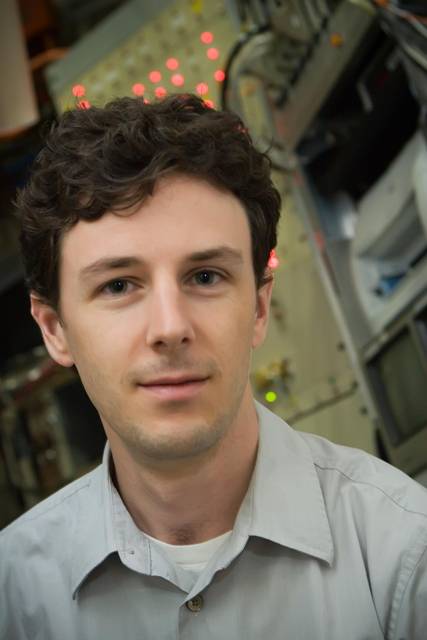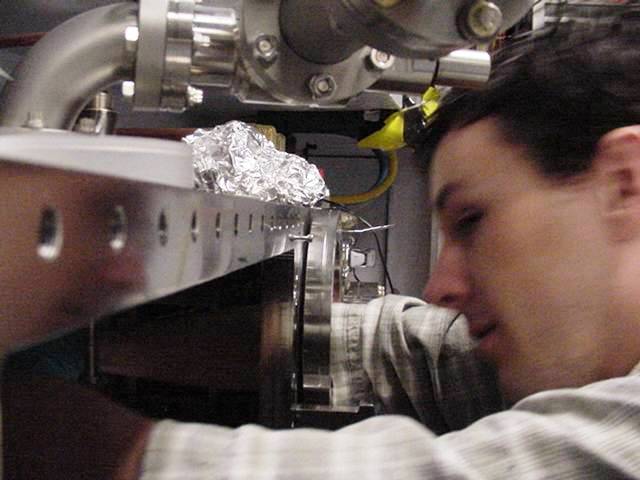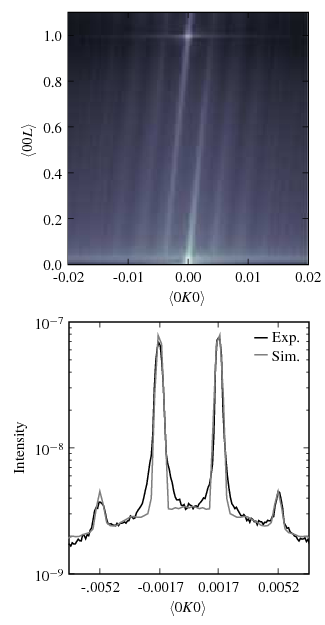X-RAY RUNS: Apply for Beamtime
2017 Nov 1 - Dec 21
2018 Feb 7 - Apr 3
2018 Proposal/BTR deadline: 12/1/17
2018 Apr 11 - Jun 4
2018 Proposal/BTR deadline: 2/1/18

Darren Dale at F3 Station
(Photo: F. Dimeo)
Contact: E. Fontes (ef11@cornell.edu)
Dr. Darren S. Dale was promoted to the rank of Staff Scientist at the Cornell High Energy Synchrotron Source (CHESS) on September 16th, 2006. Before that, Dale had been a post-doctoral associate at the laboratory following his Ph. D. thesis studies in the Materials Science and Engineering (MS&E) department at Cornell University.
Dale was a graduate student at Cornell from 1999 to 2005, studying under mentors Yuri Suzuki in the MS&E department (now at UC Berkeley) and Joel Brock, chairman of the department of Applied and Engineering Physics (A&EP). Suzuki was his thesis advisor and the dissertation work for his Ph. D. was entitled In-Situ X-ray Diffraction Studies of Pulsed Laser Deposition (PLD): Growth of Epitaxial Manganite Thin Films.
Dale was one of the first of a dozen graduate students who joined CHESS in 2000 as part of a unique project to build new X-ray beamlines and three experimental stations. The project, called “G-line,” brought together a dozen faculty and student research groups on campus that needed expanded access to X-ray stations at CHESS. Students helped design, build and now maintain the facilities that would ultimately become homes for their dissertation projects. Dale worked with the optics construction group that fabricated the 1-meter long silicon mirrors that focus X-ray beams in the vertical direction and the high-bandpass multilayers that drive the flux-hungry, time-resolved experiments at G-Line. In total, he spent two years contributing to the installation and commissioning of G-Line’s front end, the lab’s infrastructure, and designing his own experiments.

Dale assembling the
G-line multilayer optics.
(Photo: E. Fontes)
The center of his Ph. D. research effort was an instrument for X-ray studies during Pulsed Laser Deposition (PLD) thin-film growth. Dale and fellow student Aaron Fleet (A&EP) first saw their experimental station – G3 – when the room was perfectly empty. Over the course of 3 years they filled the room with toxic gas handling equipment, a high-power krypton-fluorine excimer laser, a high-vacuum film-growth chamber, motorized X-ray beamline and aperture parts, and full computer control. They worked through the difficult initial commissioning runs and helped solve problems with X-ray beam instabilities, component failures, and safety procedure definitions and implementations. In addition, Dale built a second PLD system that moved to Berkeley with Suzuki in 2003. The fact that the two systems are the same made possible a strong collaboration between Cornell and Berkeley groups and helps prepare Berkeley students to use the G3 X-ray system.
Dale’s thesis work, summarized in part in a recent Physical Review B article [1], presents a statistical model to utilize incoherent surface scattering to understand surface roughness. He developed a model to analyze specular X-ray scattering profiles. The model describes the height distribution of steps and partially completed monolayers as discrete, continuous, or a combination of both. With this type of parameterization, the model is general and can be used to analyze a variety of scattering data – including electron and neutron probes – to explain many types of interfaces and chemical scattering. In the 2005 CHESS Newsmagazine, advisor Brock boasts that “Darren’s work to describe the entire specular rod and the effects of a miscut surface has the potential to change the very language we use to present the statistical description of a growing surface.”

From Dale Ph.D.
Thesis.
(Top) A simulation of kinematic X-ray
scattering from an <001> SrTiO3 substrate
with 0.198 degree surface miscut. The miscut
creates a surface with stepped terraces; X-ray streaks
appear perpendicular to the surface. (Bottom)
Experimental data in the <0K0) direction (horizontal)
from the top simulation, at L=0.5, plotted with an
overlay of actual experimental data.
Also during his graduate career, Darren mentored two undergraduate students who were part of the Research Experiences for Undergraduates (REU) program of the National Science Foundation. Both students eventually elected to come to Cornell for graduate school and both have continued to use X-ray techniques. He is also a self-taught mechanical designer and computer programmer, doing his own 3-dimensional design for the PLD vacuum systems and writing software libraries to model PLD and X-ray scattering phenomena as well as manipulate and analyze x-ray data. He contributes to open source software projects like the “matplotlib” package, a plotting library for python which excels at generating publication-quality figures. From CHESS he is now distributing PyChess, a set of python modules designed to work with CHESS data sets, python interfaces to various databases of fundamental X-ray parameters, and is developing an open source library to simulate surface scattering.
Dale is now the CHESS station scientist for the F3 beamline and experimental hutch. He has worked with CHESS technical staff over the past year to upgrade and improve the instruments in a number of ways. First, the entire vacuum front-end of the beamline was replaced, reducing the attenuation of beryllium windows and improving reliability, and making room for a new vertical-focusing white beam glidcop mirror to be installed in mid-2007. The new mirror and optics will improve focusing and help the station support part-time use as a macromolecular crystallography resource for low-energy phasing studies. Powder diffraction, X-ray fluorescence and protein crystallography are all now supported with roll-in, roll-out optical benches designed for rapid changeover.
His personal research interests include continued thin-film research – surfaces, interfaces and materials engineering at the atomic scale – as well as new interests in coherent X-ray optics, scattering and imaging, and X-ray fluorescence spectroscopies. One new fluorescence application involves working closely with Kurt Jordan (Cornell, Anthropology and American Indian Studies) to characterize raw materials used to create objects of personal adornment found at Native American Iroquois archaeological sites. Another involves working with dendrochronologist Sturt Manning (Cornell, Department of Classics) to catalog trace metal elements in tree rings and learn about atmospheric and soil chemistry conditions existing during the lifetimes of ancient trees.
Dale joined CHESS in part to contribute to the next big development in synchrotron science. CHESS is planning to upgrade the Cornell source to an Energy Recovery Linac (ERL) - a source capable of producing fully coherent, short pulse X-ray beams. His interests now include using coherent light for X-ray imaging and he has just begun building a Talbot Interferometer. This type of interferometer uses phase and amplitude gratings to create a large-field X-ray beam for high-resolution phase contrast imaging and 3-dimensional tomography of biological samples and soft materials. The interferometer works with both high- and low-brilliance sources and can be also used to characterize the X-ray source. This includes being able to measure the transverse coherence length of incident X-ray beams and identify sources of coherent wavefront distortion in optical elements.
CHESS is happy to welcome Dale to CHESS and the ERL initiative!
